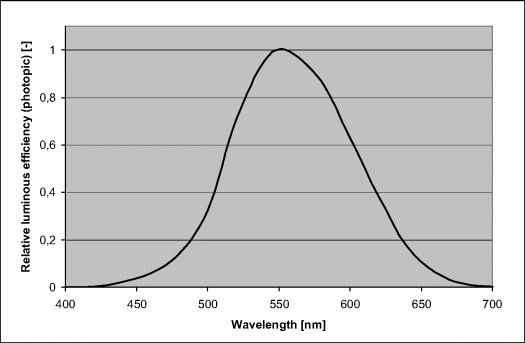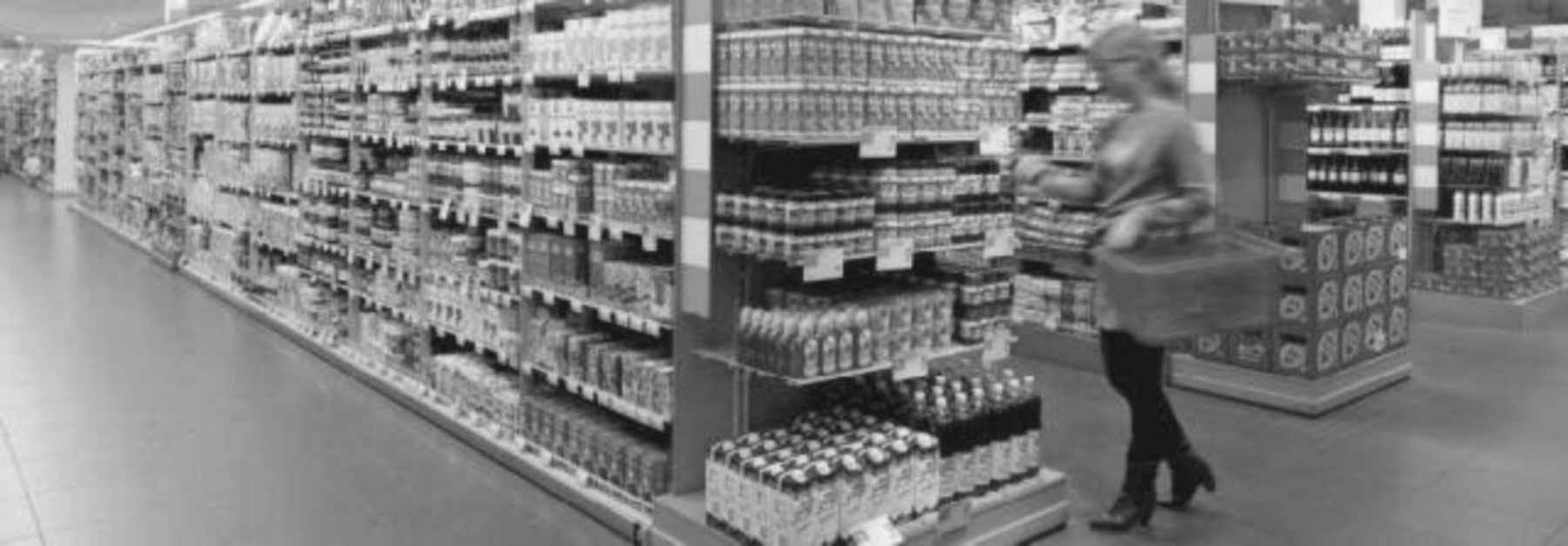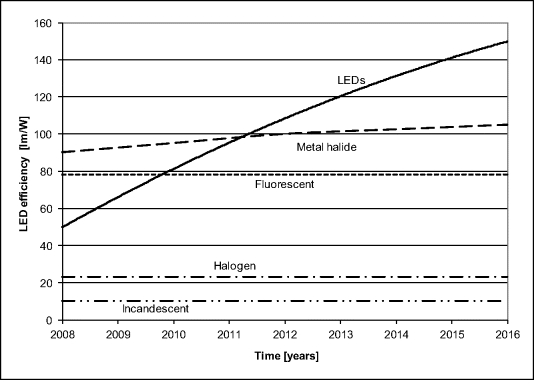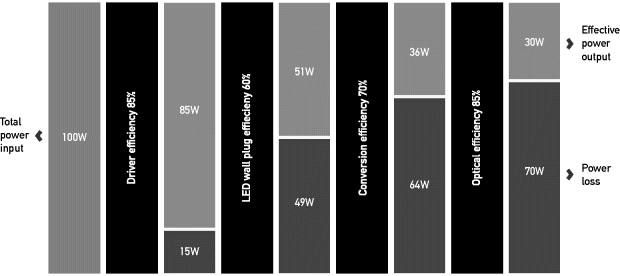3.7 Energy-Saving Lighting
3.7.1 Energy-Saving Lighting
The invention of the incandescent bulb over a century ago by Edison (in 1879) and the consequent introduction of electrical lighting have meant a huge change in people's life. It not only provides safe illumination, as there is no more open fire of the candles and gas lighting, but also provides an increased convenience, as it can be switched on by a wall switch instead of lighting each individual light point. With the use of electric light, electricity is consumed. With high penetration rates for both indoor and outdoor applications, this consumption has become very considerable. For example, according to the Next Generation Lighting Industry Alliance (NGLIA), lighting accounts for approximately 20% of current North American electricity consumption. Consequently, there has been an ongoing attempt to reduce power consumption for decades.
The attempt for energy reduction started to gain momentum with the higher penetration of electrified light after the Second World War, with fluorescent sources replacing incandescent sources. For higher power ranges, metal halide sources have taken up market share in street lighting and outdoor architecture. More recently the light quality of metal halide has improved to such a level that it has found solid ground in retail lighting. As energy consumption is such a dominant cost factor, most professional light sources are sold based on a total cost of ownership (TCO) calculation, off-setting the higher lamp and fixture costs of energy-efficient sources against the benefits of lower energy consumption and therefore lower operational cost. Next to that, lamp lifetime is an important cost of operation as some lamps, like incandescent, only live for 1000 hours. Though current light emitting diode LED light sources may life up to 50,000 hours, the payback is typically calculated on a 1- to 3-year basis.
In this section, we will go in more detail into the opportunities that are explored to reduce the energy consumption related to lighting. The figures in Table 3.7.1 give an estimate of the cost associated with lighting energy consumption and an indication of the saving potential of a switch to more efficient light sources.
Table 3.7.1 Typical energy consumption and operating cost for a 500 lm incandescent and LED fixture for a 3-year payback period at an energy price level of €0.11/KWh (industrial tariff)

For a typical fashion shop with typically 15 W/m2 energy consumption and a surface of 200 m2, one would require 60 of these 50 W incandescent fixtures, resulting in an average annual energy consumption cost of approximately €1,200. An energy consumption reduction of 20%, would lead to a €720 savings based on a 3-year payback. The switch to LED bulbs, as indicated in the table, would reduce the €1,200 energy bill to a mere €310 per year, allowing an initial investment of €2,670, or €45 per fixture. Alternatively, one could choose to use the efficient light source to obtain much higher light levels at the same installed power of 15 W/m2.
However, as always in energy usage reduction, we have to balance the benefit of energy saving with consequent drawbacks in the application. Therefore in this section we'll focus in the basics of lighting in a number of typical application areas and typical light sources.
3.7.2 Lighting Applications
The light output of the fixture itself is typically measured in lumen (lm). Lumen is the total energy that a light source emits across the visible wavelength (luminous flux), corrected for the eye sensitivity, and depicted in the human photopic sensitivity curve (Figure 3.7.1). As the eye is more sensitive to green light, this part of the visible spectrum is taken more into account than, for example, blue or red light. The luminous flux is part of the total energy that is emitted by the light source over all wave lengths (radiant flux), which includes, for example, UV and IR wavelength energy. For example, incandescent sources radiate approximately 8–10 times more IR than visible light.
Figure 3.7.1 Relative luminous efficiency (photopic) as a function of wavelength

The majority of lighting fixtures emits light that reaches the eye through reflection on other surfaces. This is called illuminance. The light intensity is characterized by the light falling on a surface area, and is measured in lux.
Next to illumination, some fixtures are used for “light to look into”, or direct-view fixture like large screens. Their light output is referred to as luminance and is measured in “candelas per square meter,” or nits. As these are often used for nonfunctional or decorative applications, these are further excluded in this section.
In office environments (see Figure C.3.2), the light is provided as part of the building, generally with limited individual possibilities to adapt to personal taste or liking. Therefore offices are in many countries subject to norms and regulations, with regard to among others minimal lux levels and glare (blinding effect of light directly reaching the eye). Typical light levels for an open-plan office are 300 lux, with 500 lux at the desk.
In hospitality environments (see Figure C.3.2), lighting is a dominant factor in creating an atmosphere or moods, with dimmed warm light in bars or restaurants or chandelier-like fixtures in lobbies. Flexibility of lighting is important to allow meeting and banquet rooms, for example, to be used as meeting rooms during the day and as wedding venues at night.
In retail environments (see Figure C.3.2), light not only is needed to see the environment but also should “sell the products” (e.g., the nice red meat of the butcher) or represent daylight conditions (e.g., for a dress in the latest fashion). Next to that, the lighting scheme might be part of the “brand identity,” whether “cheap” with many cool white linear fluorescent tubes, or “high-end” with high color-rendering accent lighting.
In outdoor lighting (see Figure C.3.2), functional lighting of the road is a main application area, but in city centers, many lighting applications are also part of the city beautification scheme and contribute to the city identity with designer poles and illumination of historic and public buildings.
In the consumer environment (see Figure C.3.2), typically other buying criteria are used. With very little legislation in the application itself, initial price is an even bigger criterion than in professional segments. Though over the last decade the penetration in homes of power-saving or compact self-ballasted fluorescent lamps (CFL-i) has increased due to substantial cost price reductions, the drawbacks of CFL-i (with regard to dimming and the diffuse light and less-than-perfect color-rendering properties) continue to give space to (eco-)halogen and incandescent lamps. In some countries, like the European Union and the United States, a recent ban on higher power incandescent lighting has been implemented giving a further boost to power-saving lamps, but for many consumers these energy-efficient alternatives are not acceptable alternatives.
In conclusion, different applications pose very different requirements toward lighting. Therefore, the optimization of energy usage requires different trade-offs for different applications. As these trade-offs have to be made at an application level, the system boundaries should not be limited to the lamp or light-emitting module itself, but should also include the luminaire and even the space or building(s) around it.
In the (LED) lighting industry, these different systems levels (Figure 3.7.3) are referred to as level 1 for the LED diode, level 2 for the LED module, and level 3 for the LED module and electronics. Level 4 represents the luminaire including optics, and level 5 represents the application.
Figure 3.7.2 Examples of lighting environments suitable for LED technology



Figure 3.7.3 System levels as defined for LED lighting systems

In some case, level 6 is referred to as services that can be provided to end users and not so much a physical representation of the system. As such it relates more to the (business) model in which light is sold, maintained, and upgraded. Level 6 is outside the scope of this section.
In practice the situation is even more complex, as for one application different decision-making units (DMUs) decide on their part of the value chain. For example the building owner decides on the initial requirements, but the architect does the design and eventually the installer decides on the actual products purchased. The light designer creates the light plan, but the space user eventually decides on the actual usage. Therefore the systems should be optimized for the different applications and stakeholders over the value chain, leading to multiple and often conflicting requirements.
As LEDs are expected to be the dominant light sources of the future, this section will mainly focus on LED sources, with reference to conventional sources.
3.7.3 Light Source Design: Efficacy
In this section the basics design parameters impacting energy consumption of LED modules are discussed. LED modules (level 2) consist of the light-emitting diode (level 1) and primary optics, and are assembled on a board that provides some electronic functions and electrical and mechanical interconnects (see Figure 3.7.3). On these levels, efficacy is used to indicate the amount of light generated per entity of consumed energy. This is expressed as lm/W. Typical efficacies of conventional light sources are 10 lm/W for incandescent, 25 lm/W for halogen lamps, 60–80 lm/W for fluorescent, and 90–100 lm/W for metal halide. These figures are purely indicative, as they can vary considerably per brand, type, power level, and so on.
The efficacy of LEDs has made enormous improvements over the last decades and is expected to further increase in the years to come, eventually becoming superior to other light sources (see Figure 3.7.4). The figure represents an average level of efficacy; as in the design of the LED module, many trade-offs can be made not just between efficacy and cost, but also with respect to color consistency, color rendering, reliability and lifetime, quality of light, and so on.
Figure 3.7.4 (Predicted) generic efficacy development of LEDs over time and a reverence to conventional light sources

For example, reducing the current through the LEDs can lead to a 20–30% higher efficacy, but requires more LEDs, resulting in a more expensive device (see Figure 3.7.5).
Figure 3.7.5 Typical luminous efficacy and flux characteristics as functions of the forward current of a LED package

Another technology option to improve efficacy in white-light applications, like down lights, is the usage of so-called remote phosphor. In this technology, the phosphors used to convert the blue light of the LEDs into white light are not applied directly on the LEDs itself, but on a plate on some distance from the LEDs. This reduces the thermal load on the LEDs itself and so keeps the LEDs in a more efficient low-temperature regime.
A third example of design choices impacting the efficacy is the use of red, blue, and off-white or lime-like LEDs, instead of phosphor-converted LEDs. Each of these LEDs has a high efficacy and as the three together make white light, there is no need for phosphor with associated stoke shift losses. A disadvantage is that additional electronics are needed for such a three-channel system and also for a temperature feedback loop to compensate for the temperature dependency of the red LEDs.
The improved efficacy will lead to a massive change-over to LED luminaires. The LED penetration is further accelerated by the rapidly lowering cost of LEDs, reducing the initial cost threshold. The US Department of Energy predicts the cost level of LED luminaires in 2015 to be at 20% of the cost level of 2010.
As LEDs are, unlike the conventional light sources, electronic components, this change-over is also the key enabler for the digitalization of lighting. This digitalization not only changes the design of LED drivers and lighting controls, but also is enabled by the changes of the light source itself.
3.7.4 Luminaire Design: Optical and Electrical Efficiency
On the next higher system levels, one or more LED modules are connected to a driver (level 3) and assembled into a luminaire or fixture (level 4). See Figure 3.7.3. Apart from the housing and mounting to the outside world, the luminaire also contains secondary optics. For example, in a spot, the secondary optic can be a reflector that creates the beam with a specified beam angle (e.g., a 10° narrow beam or a 60° wide beam). A faceted reflector structure also compensates for inhomogeneities of the LED source. Both driver and optics introduce energy losses impacting the overall efficiency. As with all systems, the overall system efficiency is a multiplication of efficiencies of individual stages in the system. Figure 3.7.6 shows an example of the efficiency buildup of a typical LED luminaire system.
Figure 3.7.6 Efficiency buildup for a typical LED luminaire

LEDs are current-driven devices; therefore, they typically need a driver like fluorescent and metal halide light sources. In LED luminaires, this typically is a separate driver that converts mains voltage in a current of 350 mA, 700 mA, or 1A depending on how hard the LEDs are driven. Efficiencies of these drivers range between 80% and 95%, with 85% being typical. In some case, for example with multistring RGB–white configurations, the power conversion is separated from the driver itself, with a power supply unit (PSU) and smaller (buck) converters on the LED PCB or close to the LEDs. This for example, allows for pulse width modulation (PWM) dimming of the LEDs, color compensation, and temperature feedback loops on the LED boards. This power configuration, however, introduces an additional conversion step and therewith an additional 5–10% efficiency loss.
In some cases the driver is integrated with the LED board. This increases the thermal load of the driver, thus affecting the lifetime of the device. This, however, allows for a specific optimization of LED configuration and driver. Similar optimizations take place for LED lamps, though in this area size limitations play an important role to keep them within the given mechanical boundaries of the conventional lamps. Next to an optimization toward efficiency, the electronic design has to fulfill requirements with regard to power factor correction and dim-ability.
Not all the light that is generated by the lamp or LED module exits the luminaire. For example, some fluorescent down lights have reported efficiencies in the order of 50%, as only 430 lm exits the fixture of the 860 lm generated by the lamps. The losses occur as part of the light is blocked by the luminaire or is reabsorbed by the lamp. As the LED module design is often closely linked to the design of the LED luminaires, there are more opportunities for optimization. LED luminaire efficiencies can be in the order of 80–95%.
Though the optical efficiency of the luminaire can be calculated based on the lumen exiting the lamp or module compare to the lumen output of the luminaire, the optical efficiency of the luminaire also depends on the application and how efficient the (set of) luminaires is able to illuminate the environment.
Good examples are cove lighting applications, which are typically done based on linear fluorescent lamps. These lamps give an omnidirectional light pattern of which only one-quarter to one-third is effectively used to light up the cove walls. LED cove lights are typically designed to give directional light, only lighting the required area. This can lead to substantial efficiency improvements in the application.
Another example is street lighting. Traditional street poles have a light concentration directly under the pole, with the light intensity rapidly decreasing for distances further away from the pole. Consequently, poles have to be placed close to each other to reach the required minimal light flux at the ground surface (see Figure 3.7.7, left). The LEDs characteristic of a small light emitter offers the opportunity to design specific optical structures that give a “bat wing” light distribution, spreading the light equally over a larger surface, and exactly putting the light where it is needed, also reducing the light spill to the street sides (see Figure 3.7.7, right). In some applications also greenish light is used, as the eye has the highest sensitivity for that light spectrum, allowing the lowest energy consumption. However, this kind of far-stretching minimization of energy consumption also has reported downsides. As the light is only projected at the street itself, people miss the “spilled” light of the omnidirectional conventional light source that conveniently lights the entrance door to the house, or that illuminates strangers passing by and thus gives a general feeling of safety. The greenish light has a very low color rendering. Consequently, people can no longer distinguish the color of a car passing by or get scared by the color of one's skin.
Figure 3.7.7 LEDs allow for further optical design optimization due to a small-sized light source, as in this example the use of “bat wing”–like optics (right side) to get more even light distribution at street level and a consequent reduction of pole numbers to fulfill requirements

3.7.5 Application Design: Effectiveness
At the next higher system level, numbered 5 in Figure 3.7.3, different luminaires together form a lighting system or application. This level can be seen as an optimization based on the effective use of light, when and where it is needed. This is done by adding intelligence to the system. Lighting controls with functionality beyond on or off can be installed for different reasons. Though energy saving is a main driver across applications, ambience setting and monitoring system performance are other common motivations.
On a system level, “lighting controls” are added to the systems. In spaces like an open office space, hallway, or living room, there is typically a “line of sight” between luminaires mutually and between users and luminaires. In these environments typically switches, dimmers, sensors, and so on are added to the lighting fixtures. In many cases this is done in with application-specific knowledge captured in the control devices. Examples include algorithms that translate daylight and presence information back to dim levels of lighting fixture close to windows (light) and those more internal (dark).
Typical office implementations, for example, are presence sensors added to the lighting system, to make sure that the lights are switched off when a space is vacated. Though simple in principle, it is a challenge to get this robust at low-cost levels as simple detectors typically detect movement and not presence, leading to arm waving to keep the light switched on. Another disadvantage is that people do not like to sit in a dark environment, even if their own desk is lighted, although these measures can lead to up to 15–25% energy reduction. To stretch savings further, daylight sensing can be added to compensate for daylight entering the space from the outside, in some cases even combined with blinds controls.
These control devices can also be linked between each other and a central control point for situations with a combination of multiple application spaces like a (number of) building(s) or shop(s). This kind of applications comes close to building or home automation systems, as lighting is one of the parameters that are to be controlled next to heating, HVAC, fire safety, telecommunications, blinds, and so on. However, lighting systems are often a separate subsystem, as specific requirements are posed due to dimming or color controls.
These larger control systems allow energy consumption monitoring, benchmarking, maintenance, and scene-setting control. In retail environments, for example, there are many chains that own hundreds or even thousands of shops across the world. Their lighting systems not only are responsible for part of their operational cost, but also lighting “shows and sells their merchandise,” and it is a recognizable element of their brand identity and consistent brand presentation to the outside world. Therefore, there is a large need to control the light and make sure it is in line with the lighting design across multiple locations. Moreover, most of these locations are run by very junior and often changing staff that is not familiar with control systems. In these applications, more central-driven systems are used. These systems, for example, allow scheduling with half-light levels before and after opening, when the staff is cleaning and filling the shelves, and full operation during opening times. Other functionality at this level is, for example, benchmarking different locations and energy performance monitoring over time.
Adding lighting controls, beyond simple switches and dimmers, substantially adds cost to the total system, not primarily as a consequence of the hardware cost, as those can be limited to 10–20% of the total lighting installation, but mainly due to the additional cost of installation and commissioning. Especially for larger systems, commissioning can be a substantial effort. This has to be taken into account when calculating total cost of ownership (TCO).
Lighting control systems are currently in rapid development due to the fast increase in calculating power in lower devices like digital drivers and digital LED modules. Another development is the introduction of IP-based networks for lighting control. IP-based communication to lighting systems will stepwise reach down from system-level controls to room controllers and eventually even to the luminaire level. This will be the next generation of lighting controls and a key enabler for the integration of intelligence and flexibility in lighting systems, and a further enabler for, for example, load shedding.
3.7.6 Conclusions and Looking Forward
Lighting makes a substantial contribution to the world's energy consumption and presents an enormous potential for energy saving. In the design of lighting systems, design choices can be made on different system levels that impact the energy consumption of the overall system.
At the lower system level, efficacy (lm/W) is the key measure. At the luminaire level, the focus is on the efficiency of electronic drivers and optics. At systems level, the effective use of the light is crucial, applying light only where and when it is needed.
For all design choices, the benefits of the reduction of energy consumption have to be offset against the trade-offs that have to be made in the application. These will vary depending on the situation and region.
Looking forward, the ongoing LEDification, digitalization, and further penetration of IP into lighting systems offer many new opportunities to be explored in the years to come.
